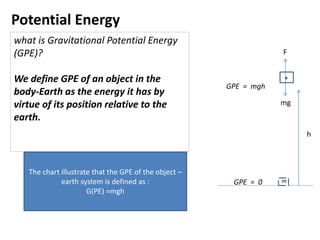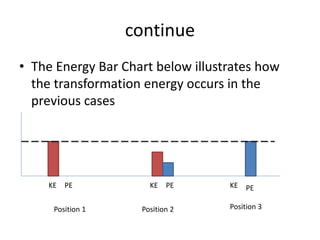Work energy power 2 reading assignment -revision 2 physics read
- 2. Basic Energy Model SystemEnvironment Energy Transfer by using force (pulling/expanding) Energy Transfer by using force (pushing/Compressing) work is done ON the system SystemEnvironment work is done BY the system
- 3. We can calculate the amount of energy removed/added to the system when using forces by using the following equation: SoŌĆ” How to determine the amount of Energy removed/ Added to the system by using forces? W = F . Ōłåx
- 4. In physics we say work is done when a force acts on something and makes it move. No motion, no work. Simple as that. Again be Reminded of this: The force should be in line with the displacement . So, we may need cosine or sine to find the component that is in line with the displacement first, before we can calculate the amount of energy removed/added.
- 5. Determine the equation to find the work done on the following object : A) B) C) D) Question 1
- 6. Mechanical Energy ŌĆó Mechanical Energy is energy that is possessed by an object due to its motion or its position. ŌĆó Mechanical energy talks about objects you can see ŌĆświth the naked eyeŌĆÖ Types of Mechanical Energy: Kinetic Energy Potential Energy So, total mechanical energy (TME) = total kinetic energy (KE) + total potential energy (PE)
- 7. Kinetic Energy ŌĆśKinetic energy of an object is the energy it possesses by virtue of its motion.ŌĆÖ An object has kinetic energy because it has motion. If an object of mass m has a speed v then it must have been accelerated from rest to that speed by some agent, doing work on KE = (┬Į )mv2 The Kinetic Energy is defined as :
- 8. Question 2 ŌĆó The diagram shows a childŌĆÖs swing. A child of a mass of 28kg is released from rest at position A. Ignore all frictional and dissipative effects, calculate : a) Kinetic energy of the child when at point B. b) Speed of the swing at point B
- 9. GPE = 0 h m GPE = mgh Potential Energy what is Gravitational Potential Energy (GPE)? We define GPE of an object in the body-Earth as the energy it has by virtue of its position relative to the earth. The chart illustrate that the GPE of the object ŌĆō earth system is defined as : G(PE) =mgh F mg
- 10. Question 3 ŌĆó A skydiver of total mass 100kg leaves an aircraft flying at 3000m and freefalls down to a height of 1200m. By this time, she has reached a constant vertical velocity of 90 m/s. Ignore all frictional and dissipative effects, a) Calculate the loss of gravitational potential energy during the fall. b) Calculate the gain in kinetic energy of the skydiver
- 11. LetŌĆÖs BrainstormŌĆ”. ŌĆó We Already know that : ŌĆó Now imagine, Suppose you throw a ball upward : 1. What does work while it is flying through the air? GRAVITY 2. Is the CHANGE in kinetic energy POSITIVE or NEGATIVE? NEGATIVE 3. Is the CHANGE in potential energy POSITIVE or NEGATIVE? POSITIVE Thus, we can conclude that : ENERGY IS CONSERVED
- 12. The law of conservation of mechanical energy states: Energy Cannot Be Created Or Destroyed, Only TRANSFORMED AND TRANSFERED! KEo KE PEo PE
- 13. Now, LetŌĆÖs investigate how does the energy transform Challenge yourself : try to fill in the blank before you move to the other slide
- 17. continue ŌĆó The Energy Bar Chart below illustrates how the transformation energy occurs in the previous cases Position 1 Position 2 Position 3 KE KE KEPE PE PE
- 18. Question 4 ŌĆó Use the figure in slide 13 as your reference. if the mass of the boy is 56 kg and the initial velocity of the skateboard is 5 m/s. Calculate the energy transformation (KE,PE,and TME) in each position. Illustrate the transformation in Energy Bar charts
- 19. Power Power is the amount of transfer/ transformation of energy in certain time taken to realise this transfer/transformation. Thus, the amount of Power can be defined as: P = ŌłåE System/ Ōłå t. In the special case that there is no heat involved (you will study ŌĆśheatŌĆÖ later, but ŌĆśheatŌĆÖ is transfer of energy by using differences of temperature), this reduces to: P = W/ Ōłå t


















